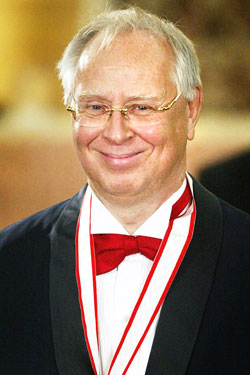
Sigmar Polke, daring visionary lord of the alchemical phantasmagoria of painting, died this morning at 69. Influential, independent, and unpredictable, he was a giant of the postwar world, as significant a painter as Johns, Warhol, or Rauschenberg. The contemporary American artist Carroll Dunham, in fact, says heÔÇÖs the greatest of all: ÔÇ£No artist of our time, and certainly no artist working on painting, is more significant than Sigmar Polke.ÔÇØ Long may his maverick material glee, otherworldly power, anarchic inventiveness, offhand easy reverie, and hallucinogenic imagination wave.
Born in East Germany in 1941, Polke moved to West Germany when he was 12, and for the rest of his life, he thought and acted like an outsider, or really a visitor from another aesthetic planet. In the early sixties, when American Pop Art was still new, Polke was already twisting it into coy, cynical shapes. He and his East German contemporary Gerhard Richter (almost ten years older) came up with a German variant of Pop they briefly called ÔÇ£Capitalist Realism.ÔÇØ Like Roy Lichtenstein, Polke hand-painted fields of dots, and he rendered them with blurs and smudges, evoking the skids and glitches in WarholÔÇÖs paintings. But instead of making slick and graphic pictures (as Lichtenstein did) or silk-screens of things Americans enjoyed (as Warhol did), Polke created abstract grids and wavering flows, and showed us things Americans feared, like Lee Harvey Oswald and particularly German things like wiener schnitzels. Painting was being reborn in Germany, a rebirth that is roaring to this day, where his influences are visible in artists as disparate as Albert Oehlen, Neo Rauch, Anselm Kiefer, Rosemarie Trockel, and the late Martin Kippenberger and Jorge Immendorff. PolkeÔÇÖs Pop imagery was broken up on the canvas, shot through with entropy. It looked like it had a mind of its own.
By the mid-sixties, when the world was just catching up to Pop, Polke was already moving on, making paintings with multiple found and invented images laid down in layers. The all-over Abstract Expressionist composition of Pollock and the wonder of Warhol came together and morphed into some sort of flickering mirage or pictorial dreamscape. In 1969, he left the plane of explanation completely, going so far as to title a painting The Higher Powers Command: Paint the Upper Right Hand Corner Black! It was an acknowledgment of the tacit, built-in mystery of painting: that we donÔÇÖt make art so much as art tells the artist what it wants to be. In those same years, he completed an enormous cycle of drawings titled The Ride on the Eight of Infinity. They are masterpieces, merging abstraction, graphic art, pictorial wit, flying faces, cryptic spatial diagrams, and experimental mark-making, and they set an agenda for appropriation that is still being picked up on. A magus was born.
Then he switched idioms again and began making photographs. Almost immediately, Polke saw photography not primarily as a tool of documentation, portraiture, or decisive moments, but understood that it was a form of magical seeing all of its own, constructed of mysterious chemical interactions and processes. He spent time in Quetta, Pakistan, photographing opium-users and hand-coloring these images. Rather than trying to perfect the prints, heÔÇÖd highlight (sometimes in gold paint) all the imperfections left by scratches on the lenses and darkroom mistakes. He brought out the nature of the way that photography itself sees.
All this happened before the American art world even ever heard of him. Polke didnÔÇÖt even have a solo show in New York until 1982 (at Holly Solomon Gallery). That exhibition, in fact, was an enormous wake-up call, and a slap in the face, to American artists, and you can still see its conceptual and material impact in the work of Americans like Dunham, David Salle, Richard Prince, Cady Noland, and countless others.
Polke never ran out of gas or nerve. For the last 30 years of his life, he experimented with two-sided paintings, honey-colored translucent resins, see-through surfaces made of plastic, arcane Renaissance and Baroque imagery, paint that disappeared when exposed to light, gunpowder, 20-million-year-old amber, images sewed together from pajama fabric. This was painting as Petri dish, art as a cauldron for life, and gypsy spirit, and I love it.

